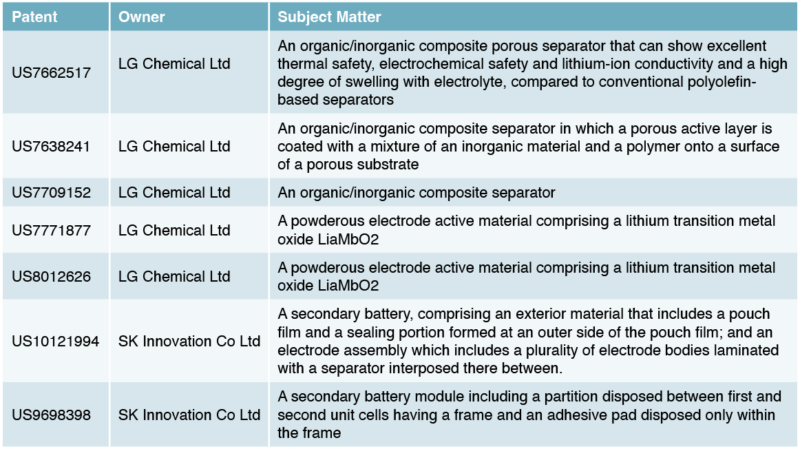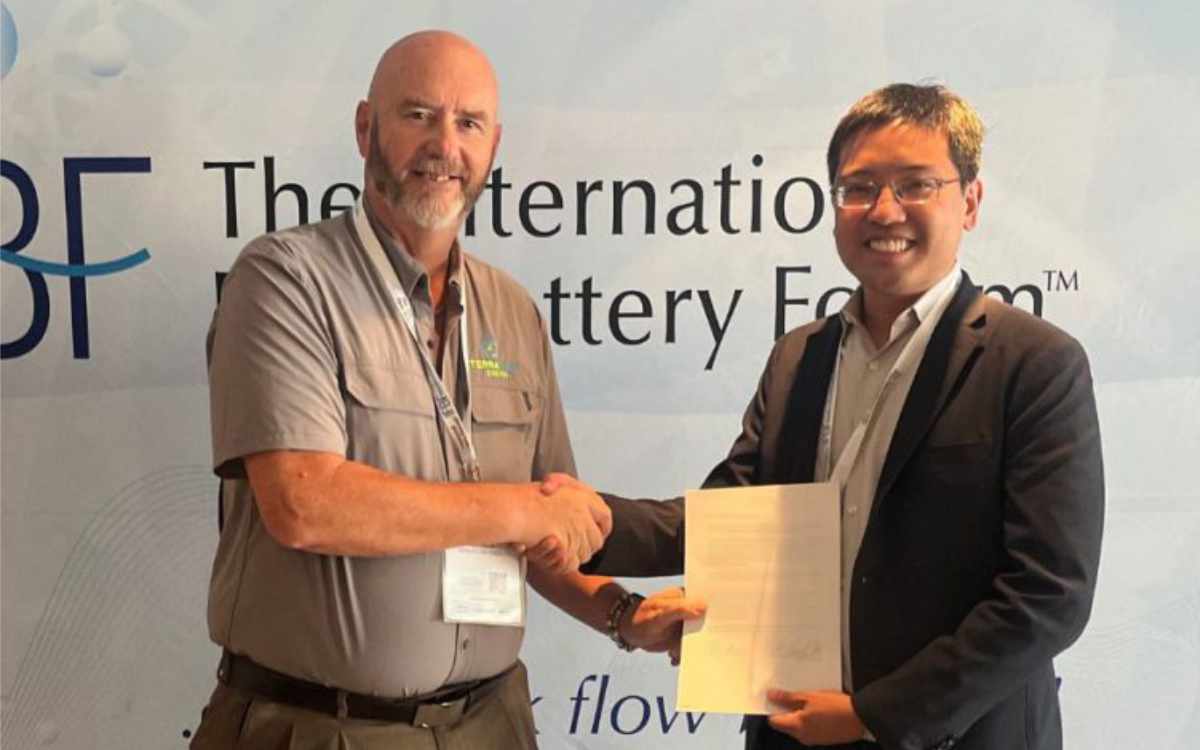
In a major ruling (file number Inv. No. 337-TA-1159) issued on 10 February, the US International Trade Commission (ITC) ruled on a dispute relating to claims that SK Innovation made use of LG Chem trade secrets surrounding their electric vehicle battery technology. The ITC investigation under US trade law centred on alleged instances of IP infringement and other unfair practices in the import of lithium-ion batteries, battery cells, battery modules, battery packs and related components and processes.
The article outlines the key takeaways for energy storage specialists and provides practical guidance for market players looking to safeguard their innovations for the long term.
Trade secrets in focus
The investigation, which began in 2019, was based around the allegation by LG Chem that between 2016 and 2018, SK Innovation misappropriated a vast number of the company’s trade secrets directed to the design, development and manufacture of electric vehicle batteries by conspiring with then-LG employees who have since moved to SK. The trade secrets were said to relate to highly proprietary manufacturing processes and systems for the production of EV batteries.
Further, it was alleged they were surreptitiously downloaded by these former LG employees and electronically copied and given to SK Innovation in a deliberate and wide-ranging operation over an extended period of time. It was also alleged by LG Chem that some of the former LG employees went so far as to identify the trade secrets they intended to misappropriate on their CVs sent to SK when seeking employment.
The gathering of evidence in trade-secret cases can be difficult and, during the ITC investigation, a motion was granted in favour of LG’s request for forensic examination of SK Innovations’ computer system due to spoliation of evidence. There was a finding in February 2020 that spoliation of evidence had occurred.
The ITC ruled in favour of LG Chem, resulting in a limited 10-year exclusion order prohibiting imports into the US of SK Innovation’s batteries. With electric vehicle sales rising significantly and a desire for a competitive market in the US, this decision had the potential to create a myriad of issues for both companies and wider market players. Significant investments from both companies in battery production in the US were already scheduled and the decision had the potential to significantly change the landscape of US-based battery production.
With numerous legal processes pending and a deadline looming for the US president Joe Biden to make an intervention to overturn the ruling of the ITC, SK Innovation and LG Chem reached a settlement. It was agreed that SK Innovation will pay LG Energy Solution two trillion South Korean won ($1.8 billion) and the companies agreed to withdraw all pending legal disputes in the United States and Korea, as well as agreeing to a ten-year non-assertion of rights.
Patents in the mix
In addition to the trade secret investigation, LG Energy Solution had accused SK Battery America of patent infringement of five of their patents in a further ITC investigation (file number Inv. No. 337-TA-1159). On 31 March, an initial determination of the ITC ruled against LG Chem stating they did not believe patent infringement had occurred or the patents themselves were invalid. SK Innovation also accused (file number Inv. No. 337-TA-1181) LG Chem of infringement of their US Patent for pouch-type battery cells before the ITC as well as in a further complaint (file number Inv. No. 337-TA-1179) relating to a second US Patent No. 9,698,398.

Patents are often considered the go-to form of IP for technology-based innovation, but this dispute between LG Chem and SK Innovation provides a high-profile example of where the patent protection fell short. In this case, it was the ability of LG Chem to show the information passed to SK Innovation was sufficient to be considered a trade secret that gave LG Chem the impactful ruling in their favour. Thus, while patents are no doubt valuable IP assets, this dispute goes to show that ensuring company information is handled in a way to give it trade secret protection should be part of a broader IP strategy. But how is this achieved?
Trade secrets versus other IP
While patent rights and trade secrets can sometimes be viewed as interchangeable, the reality is there are marked differences between the forms of IP protection each provides. On the one hand, a patent is an IP right that describes an invention and includes claims that define a scope of protection for an invention that is deemed, among other things, to be novel and inventive. Patents are published, and therefore the information within them is shared with the public. In exchange for sharing the information with the public, the patent holder is given a time-limited legal right to stop others from making, selling or using their invention as claimed.
A trade secret, on the other hand, is quite different and relates to business information that is secret, has value and is subject to reasonable protection. In contrast to a patent, trade secrets are not available to the public and therefore their exclusivity is dependent upon the measures put in place to keep them confidential within a business. Trade secrets are especially broad in scope and can be anything from a formula, practice, process, design or instrument, to a pattern, commercial method or compilation of information.
Bridging the IP gap
The hard-fought battle between SK Innovation and LG Chem underlines just how important trade secrets can be in IP disputes. Yet, while businesses employ increasingly sophisticated strategies to protect their IP using rights such as patents, trademarks and designs, recent studies show that, despite their value, many companies still do not afford their trade secrets the same degree of protection.
Sometimes this is because a business hasn’t taken the time to identify the trade secrets they have. Sometimes it might even be because they feel they don’t have any. When we think of a trade secret, the Coca Cola or KFC recipes may be the first things to come to mind, but they can be applied in many settings— and to great effect.
For LG Chem, the trade secrets related to manufacturing processes were acknowledged as having great value. While some market operators could be forgiven for thinking their manufacturing processes could be thought of as mere implementation details and not worthy of diligent protection, the reality is that all businesses should be taking steps to identify and protect their trade secrets.
LG Chem was able to show the information passed to SK could be classed as a trade secret and therefore was worthy of protection despite the seemingly blatant nature by which it was alleged the information was transferred. This case highlights that, in the digital age, accessing and copying large quantities of valuable information can be achieved quickly and easily and it can be difficult to keep track of where the information is flowing.
It is also true that many innovative companies have higher staff churn, increased data security risks and changing working environments caused by COVID-19 to manage.
In addition, laws around the world on trade secrets are changing. This means loopholes are likely to be exposed. The regulatory environment is changing too. Globally, legal reforms are challenging the efficacy of other forms of IP and tax authorities are increasingly taking a greater interest in companies’ intangible assets.
Moving forward
Against this highly challenging backdrop, innovators in the energy storage space can take a number of practical steps to get to grips with their trade secret provisions. Of course, different IP advisors will approach the challenge in various ways, but typically, the overall process should revolve around three key elements – reviewing and auditing your current awareness of trade secrets and provisions, implementing a bespoke policy and ensuring continued compliance through regular monitoring.
Seven steps to getting to grips with trade secrets
- Put in place a strategy for identifying and auditing your trade secrets
- Assess the current level of protection around them
- Create the legal and compliance framework required to protect your trade secrets
- Implement a comprehensive compliance framework so they are protected
- Remain vigilant so you can address potential threats before they become an issue
- Create an action plan so that you can take immediate action if your trade secrets are threatened
- Consider using a bespoke trade secrets audit and protection solution such as SafeGuard
As LG Chem and SK Innovation have found in this high profile and long-running case, trade secrets can make a vital contribution to the commercial and financial success of a business, as well as its ultimate valuation. They remain fragile however and in effect, can only exist as long as the trade secret is maintained. Once trade secrets are gone, they really are gone forever.
As innovators strive to continue growing in the wake of the pandemic, they overlook this important area of IP protection at their peril.












